
A bicycle, also called a bike or cycle, is a human-powered or motor-powered, pedal-driven, single-track vehicle, having two wheels attached to a frame, one behind the other. A bicycle rider is called a cyclist, or bicyclist.

Equestrianism, commonly known as horse riding or horseback riding, includes the disciplines of riding, driving, or vaulting with horses. This broad description includes the use of horses for practical working purposes, transportation, recreational activities, artistic or cultural exercises, and competitive sport.

Mountain biking is a sport of riding bicycles off-road, often over rough terrain, using specially designed mountain bikes. Mountain bikes share similarities with other bikes but incorporate features designed to enhance durability and performance in rough terrain. Mountain biking can generally be broken down into multiple categories: cross country, trail riding, all mountain, downhill, freeride and dirt jumping.

Chaps are sturdy coverings for the legs consisting of leggings and a belt. They are buckled on over trousers with the chaps' integrated belt, but unlike trousers they have no seat and are not joined at the crotch. They are designed to provide protection for the legs and are usually made of leather or a leather-like material. Their name is a shortened version of the Spanish word chaparreras. Chaparreras were named after the chaparral from which they were designed to protect the legs while riding on horseback. Like much of western horse culture, the origin of chaparreras was in the part of New Spain that later became Mexico, and has been assimilated into cowboy culture of the American west. They are a protective garment to be used when riding a horse through brushy terrain. In the modern world, they are worn for both practical work purposes and for exhibition or show use. Chaps have also been adopted for use on motorcycles, particularly by cruiser-style motorcycle riders.
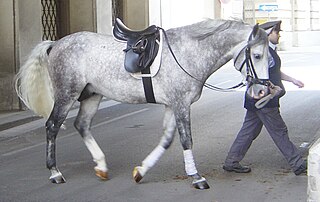
English saddles are used to ride horses in English riding disciplines throughout the world. The discipline is not limited to England, the United Kingdom in general or other English-speaking countries. This style of saddle is used in all of the Olympic and International Federation for Equestrian Sports (FEI) equestrian disciplines, except for the newly approved FEI events of equestrian vaulting and reining. Most designs were specifically developed to allow the horse freedom of movement, whether jumping, running, or moving quickly across rugged, broken country with fences. Unlike the western saddle or Australian Stock Saddle, there is no horn or other design elements that stick out above the main tree of the saddle.
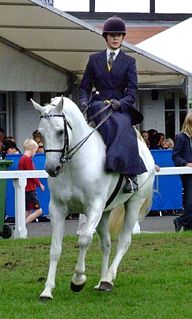
Sidesaddle riding is a form of equestrianism that uses a type of saddle which allows a rider to sit aside rather than astride an equine. Sitting aside dates back to antiquity and developed in European countries in the Middle Ages as a way for women in skirts to ride a horse in a modest fashion while also wearing fine clothing. It has retained a specialty niche even in the modern world.
Due to the nature of triathlons as a race consisting of multiple sports many pieces of technical equipment have been borrowed from other sports, or developed specifically in an effort to race faster and improve a competitors safety.

Chamois leather is a type of porous leather, traditionally the skin of the chamois, a type of European mountain goat, but today made almost exclusively from the flesh split of a sheepskin.
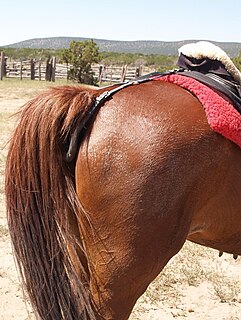
A crupper is a piece of tack used on horses and other equids to keep a saddle, harness or other equipment from sliding forward.
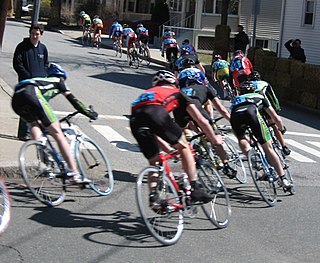
Cycling shorts are short, skin-tight legwear designed to improve comfort and efficiency while cycling. They:

Cycling gloves are gloves designed for cycling. They may provide warmth, comfort and protection.

A girth, sometimes called a cinch, is a piece of equipment used to keep the saddle in place on a horse or other animal. It passes under the barrel of the equine, usually attached to the saddle on both sides by two or three leather straps called billets. Girths are used on Australian and English saddles, while western saddles and many pack saddles have a cinch, which is fastened to the saddle by a single wide leather strap on each side, called a latigo.

Jodhpurs, also called breeches in their modern form, are tight-fitting trousers that reach to the ankle, where they end in a snug cuff, and are worn primarily for horse riding. The term is also used as slang for a type of short riding boot, also called a paddock boot or a jodhpur boot, because they are worn with jodhpurs.
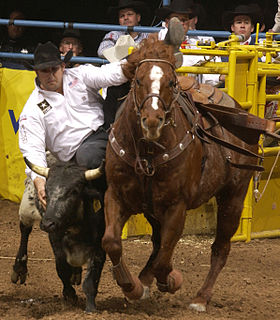
A breastplate is a piece of riding equipment used on horses. Its purpose is to keep the saddle or harness from sliding back.

The saddle is a supportive structure for a rider or other load, fastened to an animal's back by a girth. The most common type is the equestrian saddle designed for a horse. However, specialized saddles have been created for oxen, camels and other creatures. It is not known precisely when riders first began to use some sort of padding or protection, but a blanket attached by some form of surcingle or girth was probably the first "saddle", followed later by more elaborate padded designs. The solid saddle tree was a later invention, and though early stirrup designs predated the invention of the solid tree. The paired stirrup, which attached to the tree, was the last element of the saddle to reach the basic form that is still used today. Today, modern saddles come in a wide variety of styles, each designed for a specific equestrianism discipline, and require careful fit to both the rider and the horse. Proper saddle care can extend the useful life of a saddle, often for decades. The saddle was a crucial step in the increased use of domesticated animals, during the Classical Era.
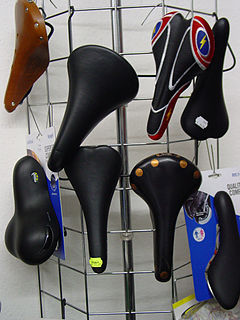
A bicycle saddle, often called a seat, is one of five contact points on an upright bicycle, the others being the two pedals and the two handles on the handlebars. At any point in time there can be one, two, three, four or five contact points between rider and bike sharing support of rider body weight and applying rotation torque to the pedals. The bicycle saddle has been known as such since the bicycle evolved from the draisine, a forerunner of the bicycle. It performs a similar role as a horse's saddle, not bearing all the weight of the rider as the other contact points also take some of the load.

Bareback riding is a form of horseback riding without a saddle. It requires skill, balance, and coordination, as the rider does not have any equipment to compensate for errors of balance or skill.

Compression garments are pieces of clothing that fit tightly around the skin. In medical contexts, compression garments provide support for people who have to stand for long periods or have poor circulation. These come in varying degrees of compression, and higher degree compression sleeves, such as sleeves that provide compression of 20–30 mmHg or higher, typically require a doctor's prescription. Compression garments worn on the legs can help prevent deep vein thrombosis and reduce swelling, especially while traveling.

Protective equipment in gridiron football consists of equipment worn by football players for the protection of the body during the course of a football game. Basic equipment worn by most football players include helmet, shoulder pads, gloves, shoes, and thigh and knee pads, a mouthguard, and a jockstrap or compression shorts with or without a protective cup. Neck rolls, elbow pads, hip pads, tailbone pads, rib pads, and other equipment may be worn in addition to the aforementioned basics. Football protective equipment is made of synthetic materials: foam rubbers, elastics, and durable, shock-resistant, molded plastic. Football protective equipment has remained consistent in use for decades with some slight modifications made over the years in design and materials. The assignment and maintenance of football gear belongs to the team equipment manager.

A cycling pad, also known as "chamois" or "bikepad" or "Fondello" (Italian), "Gamuza" or "Badana" (Spanish), Peau (French) is a protective insert that is applied in cycling shorts with the main purpose of protecting the groin from the friction of constant and prolonged saddle contact. Cycling pads were developed at the beginning of the 1900s and were exclusively made of deer leather up until the 1980s, when technical fabrics were introduced, and allowed for enhanced performance.

















